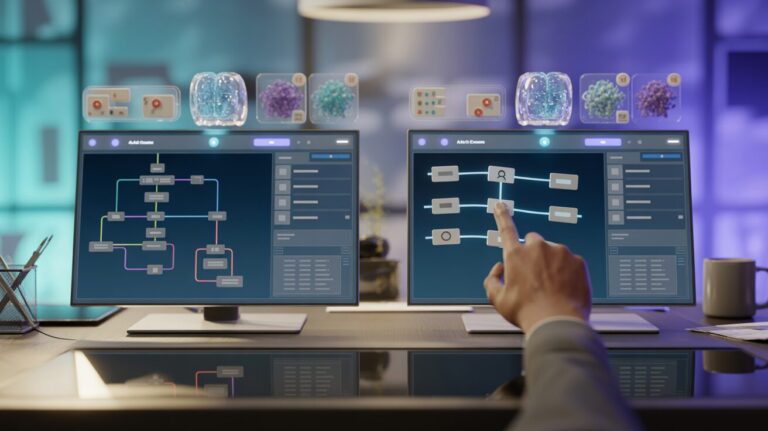Table of Contents
- Understanding No-Code AI App Builders
- Benefits of No-Code AI Platforms
- Key Features of Effective No-Code AI Tools
- Common Types of AI Applications You Can Build
- How No-Code AI Platforms Work
- Real-World Applications Across Industries
- Getting Started With Your First AI App
- Comparing No-Code AI Platforms
- Future of No-Code AI Development
Artificial intelligence has transformed from a distant, complex technology reserved for tech giants and specialized developers into an accessible tool that anyone can leverage. At the heart of this democratization are no-code AI app builders — platforms that enable individuals with no programming background to create sophisticated AI-powered applications.
If you’ve ever been intrigued by the potential of AI but felt intimidated by the technical barriers, you’re not alone. The good news is that no-code AI app builders are specifically designed to bridge this gap, allowing educators, content creators, healthcare professionals, small business owners, and professionals from virtually any industry to harness the power of AI without writing a single line of code.
In this comprehensive guide, we’ll explore what no-code AI app builders are, how they work, and how you can use them to create powerful AI applications that solve real problems and enhance your professional capabilities — all without technical expertise. Whether you’re looking to build a customer service chatbot, an intelligent content recommendation system, or a personalized learning assistant, the world of AI is now at your fingertips.
Understanding No-Code AI App Builders
No-code AI app builders are platforms that provide visual interfaces for creating artificial intelligence applications without requiring programming skills. These innovative tools use intuitive, visual elements like drag-and-drop components, pre-built templates, and guided workflows to replace what would traditionally require extensive coding knowledge.
The core premise is simple but powerful: abstract away the complex technical details of AI development and provide accessible tools that allow anyone to transform their ideas into functioning AI applications. This approach fundamentally changes who can participate in AI creation.
Traditional AI application development typically involves several technical requirements:
- Programming expertise in languages like Python
- Knowledge of machine learning frameworks and libraries
- Understanding of data preprocessing techniques
- Experience with model training and optimization
- Skills in application deployment and maintenance
No-code AI platforms eliminate these requirements by providing pre-built components that handle these technical aspects behind the scenes. Instead of writing code to integrate with AI models, users can simply connect elements visually to define how their application should function.
The approach is similar to how website builders revolutionized web development, allowing non-developers to create professional websites. Now, the same transformation is happening with artificial intelligence.
Benefits of No-Code AI Platforms
The rise of no-code AI app builders brings numerous advantages that are transforming how individuals and organizations approach AI implementation. These platforms deliver value across multiple dimensions:
Democratization of AI Technology
Perhaps the most significant benefit is accessibility. No-code AI platforms put powerful technology in the hands of subject matter experts, business analysts, educators, healthcare professionals, and entrepreneurs who understand their domain challenges intimately but lack technical AI expertise. This democratization allows for AI solutions that address specific, real-world problems across diverse industries.
Speed and Efficiency
The traditional AI development cycle can take months, involving data scientists, engineers, and extensive iteration. No-code platforms compress this timeline dramatically, enabling users to create functioning AI applications in days or even hours. For example, platforms like Estha allow users to build custom AI applications in just 5-10 minutes, significantly accelerating the path from concept to implementation.
Cost Reduction
Building AI applications traditionally requires substantial investment in technical talent, which can be prohibitively expensive for smaller organizations. No-code platforms reduce these costs by eliminating the need for specialized developers. This cost efficiency makes AI accessible to small businesses and individuals who previously couldn’t afford custom AI solutions.
Increased Innovation
When the barriers to creating AI applications are lowered, innovation flourishes. Domain experts can directly translate their knowledge into AI solutions without technical intermediaries, leading to more diverse and specialized applications. This direct implementation preserves the nuanced understanding that sometimes gets lost when ideas have to be translated between domain experts and technical teams.
Reduced Technical Debt
Custom-coded AI applications often create technical debt that requires ongoing maintenance by specialized developers. No-code platforms generally handle infrastructure, maintenance, and updates automatically, reducing long-term technical overhead and allowing creators to focus on improving their applications rather than maintaining them.
Key Features of Effective No-Code AI Tools
Not all no-code AI platforms are created equal. The most effective tools share certain key features that enable users to create sophisticated applications easily:
Intuitive Visual Interface
The foundation of any good no-code platform is its interface. Leading platforms offer drag-drop-link functionality that makes building AI applications as intuitive as creating a flowchart or presentation. These visual interfaces should be accessible enough for beginners while providing sufficient complexity for advanced applications.
For example, Estha’s interface allows users to visually connect different elements of their AI application, defining the relationship between components without writing code. This visual approach makes the logic of the application transparent and easy to modify.
Pre-built AI Components
Effective no-code platforms provide a library of pre-configured AI components that users can incorporate into their applications. These components handle specific functions like:
- Natural language processing
- Sentiment analysis
- Image recognition
- Data analysis and prediction
- Recommendation systems
These pre-built components encapsulate sophisticated AI capabilities in easy-to-use modules, removing the need to understand the underlying algorithms while still providing powerful functionality.
Customization Without Coding
While no-code platforms eliminate the need for programming, they still need to offer substantial customization options. The best platforms allow users to tailor AI behavior through configuration settings, training data selection, and behavior rules without requiring coding knowledge.
This level of customization ensures that applications can be fine-tuned to specific needs while maintaining the accessibility of the no-code approach.
Integration Capabilities
AI applications rarely exist in isolation. Effective no-code platforms provide straightforward ways to integrate with existing systems, databases, and workflows. This might include:
- API connections to other services
- Database integration
- Webhook support
- Export and embedding options
These integration capabilities ensure that AI applications can function as part of broader technology ecosystems rather than isolated tools.
Support for Deployment and Sharing
Creating an AI application is only part of the journey. Platforms should also facilitate easy deployment, sharing, and even monetization of completed applications. This includes features for publishing applications to the web, embedding them in existing websites, or distributing them through marketplaces.
Common Types of AI Applications You Can Build
No-code AI platforms enable the creation of diverse applications across multiple domains. Here are some of the most common types of AI applications that non-technical users can create:
Conversational AI Chatbots
Perhaps the most accessible entry point to AI application building is creating conversational chatbots. These intelligent assistants can be designed to answer customer questions, provide recommendations, collect information, or guide users through processes.
Modern no-code platforms allow you to create sophisticated chatbots that understand natural language, maintain context throughout conversations, and provide helpful, human-like responses without any programming. For example, a small business owner could create a customer service bot that handles common inquiries about business hours, services, and pricing.
Expert Advisory Systems
No-code tools enable the creation of AI advisors that encapsulate specialized knowledge. These systems can provide recommendations, diagnose problems, or offer guidance based on domain-specific expertise.
For example, a financial advisor could build an application that helps clients understand investment options based on their risk tolerance and goals. Similarly, a healthcare professional might create a symptom checker that helps patients determine when to seek medical attention.
Interactive Learning Tools
Educators and trainers can develop AI-powered learning applications that adapt to individual student needs. These might include interactive quizzes that adjust difficulty based on performance, personalized learning paths, or virtual tutors that provide customized explanations.
These applications can transform traditional education by providing personalized learning experiences without requiring technical expertise from educators.
Content Creation Assistants
Content creators can build AI tools that help generate ideas, check writing for clarity and engagement, or even produce drafts based on specified parameters. These assistants can dramatically increase productivity for writers, marketers, and communication professionals.
Decision Support Systems
Business professionals can create applications that analyze data and provide recommendations for decision-making. These might include sales forecasting tools, inventory optimization systems, or risk assessment applications.
The beauty of no-code platforms is that these applications can be built by the same people who understand the business challenges, without requiring technical intermediaries.
How No-Code AI Platforms Work
To demystify the process further, let’s look at the typical workflow for creating an AI application using a no-code platform:
1. Define Your Objective
Before touching the platform, you’ll need to clearly define what you want your AI application to accomplish. This includes identifying the problem it will solve, the users it will serve, and the specific functions it should perform.
2. Select a Template or Start From Scratch
Most no-code platforms offer templates for common application types to accelerate development. You might start with a chatbot template, a recommendation engine starter, or begin with a blank canvas if your application is unique.
3. Design the User Interface
Use the platform’s visual design tools to create the user interface for your application. This might involve selecting components like text fields, buttons, images, and conversation windows, then arranging them in an intuitive layout.
4. Configure AI Behavior
This is where you define how your application’s AI will function. Depending on your platform and application type, this might involve:
- Training the AI with example conversations or data
- Setting parameters for how the AI should respond in different scenarios
- Creating decision trees or workflows that guide AI behavior
- Connecting different AI components to work together
For instance, on the Estha platform, you might use the drag-drop-link interface to connect a natural language processing component to a knowledge base component, defining how the AI will access information to answer user questions.
5. Test and Refine
Most platforms provide built-in testing tools that allow you to interact with your application as a user would. This testing phase helps identify areas where the AI might need additional training or where the user experience could be improved.
6. Deploy and Share
Once your application is working as intended, you can deploy it through the platform’s publishing options. This might include generating a web link, embedding the application in your existing website, or making it available through a marketplace.
Real-World Applications Across Industries
No-code AI platforms are enabling innovation across diverse sectors. Here are examples of how different professionals are using these tools:
Education
Educators are creating personalized learning experiences with AI applications that adapt to student progress. For example, a mathematics teacher might build an application that provides customized problem sets based on each student’s strengths and weaknesses, offering additional explanation when patterns of mistakes are detected.
Healthcare
Healthcare providers are developing patient education tools, preliminary symptom assessors, and wellness coaches. A nutritionist might create an AI assistant that helps patients maintain food diaries, provides personalized meal suggestions, and offers accountability support between appointments.
Small Business
Small business owners are building customer service chatbots, product recommenders, and appointment schedulers. A boutique clothing store could create an AI stylist that asks customers about their preferences and occasions, then suggests appropriate outfits from their inventory.
Content Creation
Writers and content marketers are developing idea generators, content optimizers, and automated research assistants. A blogger might build an AI tool that suggests topics based on current trends, helps outline articles, and checks drafts for readability and engagement.
Financial Services
Financial advisors are creating personalized financial education tools and preliminary assessment applications. A financial planner could build an application that helps clients understand different savings strategies based on their goals, risk tolerance, and timeline.
Getting Started With Your First AI App
Ready to create your first AI application? Here’s a step-by-step approach to get you started:
1. Identify a Specific Need
The most successful first projects address a clear, limited need rather than attempting to solve complex problems. Consider starting with a focused application like:
- A FAQ chatbot for your website or business
- A personalized recommendation tool for your products or services
- A simple interactive guide for a process you frequently explain to others
2. Choose the Right Platform
Evaluate no-code AI platforms based on your specific needs. Consider factors like:
- Ease of use for beginners
- Availability of templates or examples similar to your project
- Cost structure (free tier, subscription, usage-based)
- Integration capabilities with your existing systems
For many beginners, platforms like Estha offer an ideal starting point with their intuitive interfaces and comprehensive support resources.
3. Gather Your Content
Before building, collect the information your AI will need:
- For a chatbot: Common questions and their answers
- For a recommendation system: Products/options and their attributes
- For a learning tool: Educational content and assessment questions
Having this content prepared will streamline the development process.
4. Start Simple, Then Expand
Begin with core functionality and test thoroughly before adding complexity. This incremental approach helps you learn the platform while ensuring each component works correctly before building upon it.
5. Seek Feedback and Iterate
Once you have a working version, share it with colleagues or target users for feedback. Use their insights to refine and improve your application before wider deployment.
Comparing No-Code AI Platforms
When evaluating no-code AI platforms, consider these key differentiating factors:
Ease of Use vs. Complexity
Some platforms prioritize simplicity for absolute beginners, while others offer more advanced capabilities with a steeper learning curve. Consider your technical comfort level and the complexity of applications you want to build.
Estha strikes a balance by offering an intuitive drag-drop-link interface that remains accessible to beginners while providing sufficient depth for sophisticated applications.
Specialized vs. General-Purpose
Some platforms focus on specific AI application types (like chatbots only), while others support a wide range of AI applications. General-purpose platforms provide more flexibility but may have a slightly steeper learning curve.
Development Speed
Platforms vary in how quickly you can move from concept to working application. Some emphasize rapid development with extensive templates, while others require more configuration for customized results.
For example, Estha’s approach allows users to create functioning AI applications in as little as 5-10 minutes, making it ideal for quick implementation.
Ecosystem and Support
Consider the platform’s supporting ecosystem, including:
- Educational resources and tutorials
- Community forums and support
- Templates and pre-built solutions
- Marketplace for sharing or monetizing creations
Comprehensive ecosystems like Estha’s EsthaLEARN, EsthaLAUNCH, and EsthaeSHARE provide added value beyond just the building tools, supporting users through education, launch support, and distribution options.
Future of No-Code AI Development
The no-code AI movement is still in its early stages, with exciting developments on the horizon:
Increased Sophistication
As underlying AI technologies advance, no-code platforms will enable increasingly sophisticated applications without adding complexity for users. This will continue to narrow the gap between what professional developers and non-technical users can create.
Domain-Specific Solutions
We’re likely to see more specialized no-code AI platforms emerge for specific industries like healthcare, finance, education, and retail. These platforms will include pre-built components and templates tailored to industry-specific use cases.
AI-Assisted Creation
In a fascinating recursive development, AI itself is beginning to assist in the creation of AI applications. Future no-code platforms may include AI assistants that suggest components, help optimize application behavior, or even generate entire application sections based on natural language descriptions of what the user wants to achieve.
Integration with Emerging Technologies
No-code AI platforms will increasingly integrate with other emerging technologies like augmented reality, Internet of Things (IoT), and blockchain, enabling non-technical users to create applications that leverage these powerful combinations.
Conclusion: The Democratization of AI
No-code AI app builders represent a fundamental shift in who can create and benefit from artificial intelligence. By removing technical barriers, these platforms are enabling a diverse range of professionals to implement AI solutions that address specific challenges in their domains.
This democratization brings several profound benefits:
- More diverse perspectives influencing AI development
- Domain expertise directly incorporated into AI applications
- Wider distribution of AI’s benefits across industries and organization sizes
- Accelerated innovation as more people contribute to the AI ecosystem
Whether you’re an educator looking to create personalized learning experiences, a content creator seeking to enhance your productivity, a healthcare professional aiming to improve patient education, or a small business owner wanting to provide better customer service, no-code AI platforms provide accessible entry points to leverage artificial intelligence.
The era where AI application development was restricted to those with technical expertise is ending. Today, anyone with domain knowledge and innovative ideas can create powerful AI applications that solve real problems and deliver meaningful value.
As you begin your journey with no-code AI development, remember that the most successful applications address specific needs with focused solutions. Start small, learn through experimentation, and gradually expand your capabilities as you gain confidence and experience.
Ready to Create Your First AI Application?
Build custom AI applications in minutes with Estha’s intuitive drag-drop-link interface — no coding or technical knowledge required.



